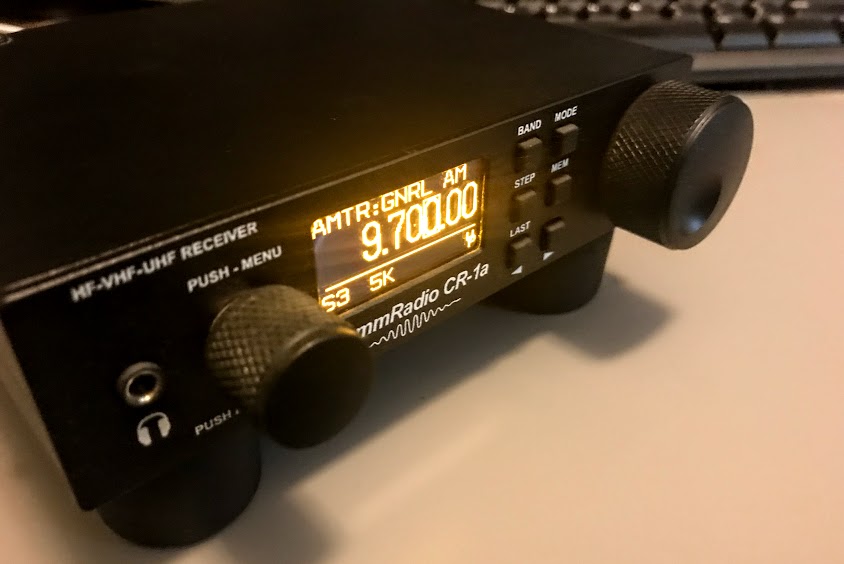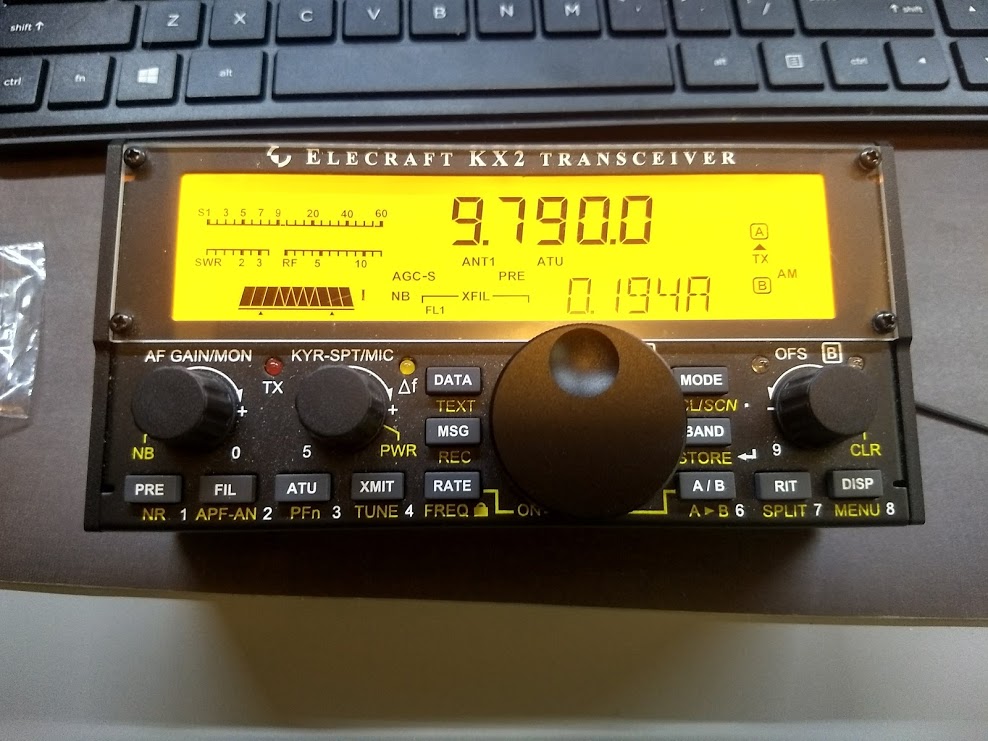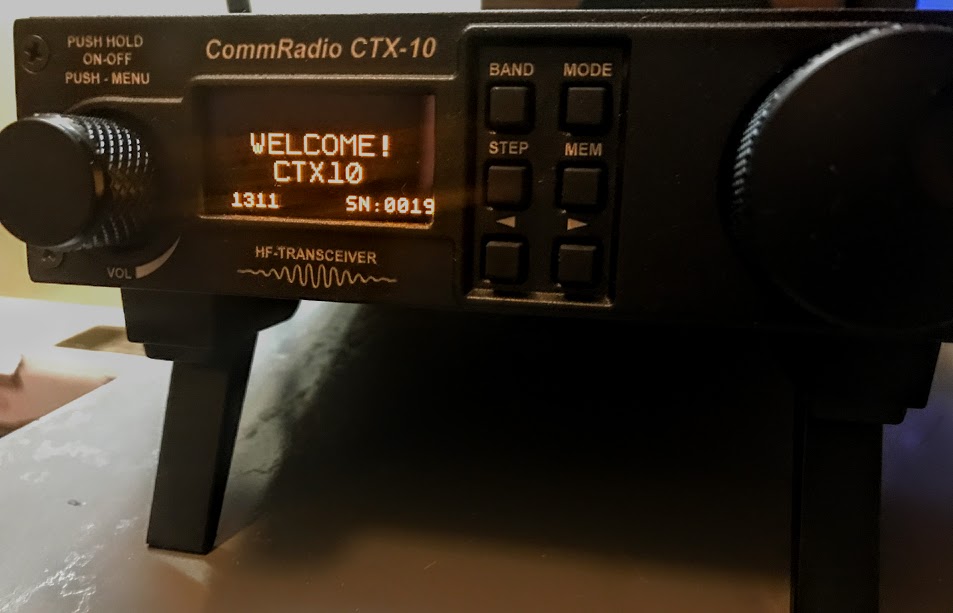Here at SWLing Post HQ we’ve been under a Winter Storm Warning since yesterday–it’s not set to expire until sometime tomorrow. This storm hasn’t been all snow–it’s a mixture of snow and ice. If this continues, I fully expect to lose power at some point today.
In general, we’re prepared to handle this sort of thing: our refrigerator and freezer are powered by solar and completely off-grid, we have a super efficient RAIS woodstove to keep us warm and of course, we have a generator at the ready if needed.
Playing radio off-grid
As I write this post, I’m listening to the Signal Corps BC-348-Q (photo above) which is tuned to a local AM broadcaster. It’ll fill my shack with local news/tunes and its vintage valves will do a fine job warming this small room until the power eventually goes out.
When it does go out, I’ll switch to my blackout buddy, the CommRadio CR-1A.
 I find that the CR-1A is nearly ideal for off-grid and field listening, as long as you have a good external antenna. The internal Li-Ion battery powers the thing for ages and it has an incredibly capable receiver.
I find that the CR-1A is nearly ideal for off-grid and field listening, as long as you have a good external antenna. The internal Li-Ion battery powers the thing for ages and it has an incredibly capable receiver.
Of course, I also have an Elecraft KX3 and KX2 which can be powered by battery, but I tend to use the CR-1A for broadcast listening and save the KX2/KX3 for off-grid ham radio QRP fun.
In addition, I have the new battery-powered CommRadio CTX-10 transceiver in the shack.
I’ve been receiving numerous emails about this particular field rig because there are so few CTX-10 reviews out there even though it’s been on the market since late July.
Please note that I’ve been giving the CTX-10 a thorough evaluation over the past few weeks and plan to publish my initial review in the next few days.
Bye-bye noise!
Even though I live in a very rural and remote area with little-to-no RFI, when the power is cut, my noise floor still drops . We’re not immune–like most homes, we have power supplies and devices that emit radio interference.
It’s funny: most urban radio enthusiasts I know don’t fear power outages, they prepare for and embrace them! When all of those RFI-spewing devices go silent, it’s simply amazing what you can hear from home on frequencies below 30 MHz with pretty much any receiver.
Personally, as long as I have a means of 1.) powering my radios, and 2.) making coffee (extremely important), I consider myself properly prepared.
I’ve always got those two points covered.
Bring it, old man winter! I’m ready to play radio!
Do you enjoy the SWLing Post?
Please consider supporting us via Patreon or our Coffee Fund!
Your support makes articles like this one possible. Thank you!





I know you’re already set up to deal with offgrid status, but I still believe that a kit like this one
https://www.amazon.com/ECO-WORTHY-Turbine-Generator-Polycrystalline-Charging/dp/B00ZECMODU
(just an example, there are others) may be a good way to power some radios and may be also useful for dxpeditions; it will allow to use wind and sun to recharge batteries and keep the rig going 😉 !
Here in Central Europe we enjoy a mean power outage of about 20 min per year. But as always: Don’t trust a statistic you did not do yourself 🙂
Even here it happens that an area gets cut off as it happend in December of 2005 in northern Germany (Münsterländer Schneechaos). Some villages had no electricity for five days.
As a radio amateur I think I should be prepared for such an event. About the easiest way is to modify an uninteruptable powersupply (UPS) as you get it in about any computer store. Most of these contain a 12 V/7 Ah lead-gel battery. Normally the UPS has an easy way to access and replace the battery.
If the minus pole of the battery has a connection to protective ground, as most have, you can easily use it as an emergency power supply for a QRP rig: Add a 12 V socket to the UPS and connect it to the battery polses. Do not forget a fuse in the plus line!
Normally you “switch off” the UPS, i.e. it poweres down its output sockets. But it still charges its battery as long as you have the UPS connected to the grid. Put it after the main power switch of your shack and it will keep your battery charged. The UPS does not discharge its battery when you disconnect it from the grid as long as you have it switched off.
If your handheld transceiver operates from less than 12 V you should add a voltage converter. At Amazon you find “regulator postage stamps” for about 2$ a piece, but they sell them only in packages of 5. Big problem! 🙂
I have done so for my FT-817: Directly connected to a 12 V battery it draws 350 mA which means about 20 h of standby operation from a 7 Ah battery. Operated at 8.5 V it only draws some 250 mA from the 12 V battery which extends the standby time to 24 h.
24 hours should translate to about five days of operation: You need not let your station run around the clock and would transmit much. Or add another lead-gel battery.
Thomas, thanks so much for the article about enjoying shortwave radio during power outages. It really brought back some memories. I’m afraid that I too look forward to power failures with glee when they magically turn my Northern California suburb into an electrically quiet reception zone. Depending upon the shortwave band in use RFI can contribute as much as seven S-units of noise to my external antennas at home. I need to travel four miles out of town and use a 20′ vertical mag mount whip to find good shortwave conditions on all bands.
Solar power panels don’t work very well at night or under overcast winter skies. I have some substantial flexible panels that are used on the boat but I have yet to break them out for power failures at home. Outages are rare here thanks to reliable underground utilities. There is quite a collection of Eneloop and Li-ion IMRs in rotation that will last for days. There is also a good stock of Duracell alkaline batteries in reserve.
Wood provides backup heat at home. For lighting there is the usual assortment of LED lanterns and a few kerosene lamps for both heat and lighting. The kerosene lamps are vintage Aladdin lamps from the 1940’s that belonged to my grandparents. These are unpressurized mantle lamps. They provide both light and usable heat. I learned how to use Aladdin lamps as a kid in rural Northern Idaho.
Aladdin lamps are something of an American institution. The lamps still represent peak technology in non-electric lighting. The original owners sold out in the late 1950’s but the company is still in business and thrives in a niche market. Lamps and new parts are still in production. Vintage Aladdins and parts abound on eBay. This is my favorite online store for all things Aladdin including new parts. https://www.ebay.com/str/imperiallightingco/Aladdin-Branded-Items/_i.html?_storecat=22989002011
The longest power outage I experienced was five days in North Carolina in the late 1960’s. A whopper ice storm brought overhead power lines down for miles around. No high school that week!
That’s very interesting regarding the Aladdins–we have one similar oil lamp here at our home.
Our solar system doesn’t charge during events like this–the panels are not easily accessible on my roof. We have a good 5 days of reserve, however, in our battery bank so that usually takes care of things and keeps us having to hit the generator.
Yeah–I suppose I really do like power outages most of the time–especially if there’s an end in sight!
The longest I’ve been without power was in the aftermath of Hurricane Hugo in the late 1980s; over 2 weeks (17 days, I believe)! That particular event is why our house was designed to be off-grid. It had that much impact.